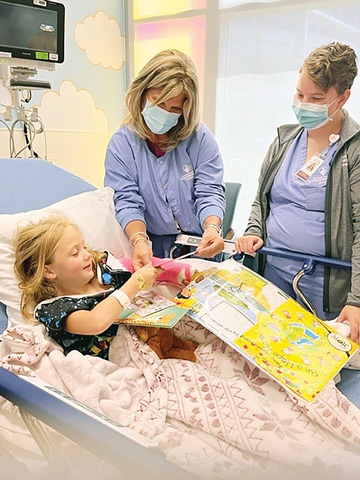• Non-narcotic analgesia. This means patients receive zero parenteral narcotics during surgery. “Zero,” emphasizes Dr. Delcore. Preoperatively, patients get two oral naproxen and their choice of one low-dose
oxycodone or tramadol. Twenty to 25% of patients opt to take only the naproxen, a choice Dr. Delcore welcomes. “We don’t think opioids are a bad thing when taken orally,” he explains. “They hit mu receptors and
mitigate some pain. It’s the IV opioids that make patients groggy and nauseous. We’re not stingy with post-op medicine and avail it to patients after surgery, but our patients aren’t in much pain afterward, so they generally
don’t need much.”
• Periarticular blocks. Employing these blocks, and placing them well, means the surgeons at Cedar Orthopaedic don’t use multi-ingredient intraoperative cocktails. No expensive, allegedly long-acting liposomal bupivacaine.
No indwelling catheters and sending patients home with pain pumps. Instead, the surgeons fastidiously inject each layer with lidocaine 1% and .5% bupivacaine without epinephrine. “Done well, it makes for easy anesthesia every time,”
says Dr. Delcore. “It’s not just injecting and infiltrating. The technique works like a piston, by which you’re repeatedly layering the injections and anesthetics to fan it throughout the whole subcutaneous layer.”
The method essentially lets surgeons block pain as they go through the procedure. Dr. Delcore’s blockcade begins at the incision, then proceeds to the arthrotomy/capsular layer, medial tibial peel, infrapatellar fat pad excision
site, lateral patellar peel if required, supracondylar femoral sweep, popliteal spaces, meniscal resection beds and then the incision site again at the end of the procedure.
If the patient is feeling any discomfort, it’s very minor and quickly detected by the anesthesiologist, so Dr. Delcore knows to back up and administer more of the local anesthetics. “The patients are riding so low with non-narcotic
anesthesia, they exhibit only slight blood pressure, tachycardic or respiratory issues, so in those events you simply block that area again until it’s numb and they calm down.”
These blocks always last into the next day, which Dr. Delcore says is all patients need to go home healthy and happy, and ready for a good night’s sleep and for their physical therapy.
• Early mobilization. Striking the balance between keeping patients comfortable after their surgery and minimizing their risk for PONV, lethargy, having difficulty awakening and post-op malaise in general is tricky. Cedar
Orthpaedics achieves it in a way that they’re ready to walk soon after their procedures. While the pain from the surgery is usually mild to moderate, it’s the muscles spasming from laying still after the procedures that causes
the pain. “Early mobilization is key because secondary pain limits their movement,” says Dr. Delcore. “The more they lay there, the more secondary pain they experience.”
Preoperative counseling in this regard is paramount. Patients are told that the soft tissue surrounding the surgical site will be strained. To make it hurt less, they’re going to be prompted to get up and move around within 45 minutes
of surgery. “They know that this is part of the secret sauce to gain their confidence and psychologically empower themselves to know that it doesn’t hurt to walk and put weight on their new joint,” says Dr. Delcore.
Physical therapists at Cedar Orthopaedics aren’t shy, encouraging patients to fully walk through their steps without favoring their leg or walking gingerly. Putting their weight on the new joint helps to stop the spasms that are causing
pain, and early walking thwarts scarring and arthrofibrosis issues that accompany stiff joints.
Too often, explains Dr. Delcore, providers react to post-op pain by immediately providing a narcotic, which he says leads to prolonged immobility. “Don’t cater to the pain first,” he says. “It’s just pain. Get
them up and walking. Patients should be empowered to know that the pain doesn’t mean the new joint is going to break. Walking is what’s going to reduce their pain by breaking muscle spasms and setting the tone for their continued
early physical therapy.” OSM
.svg?sfvrsn=be606e78_3)

.svg?sfvrsn=56b2f850_5)